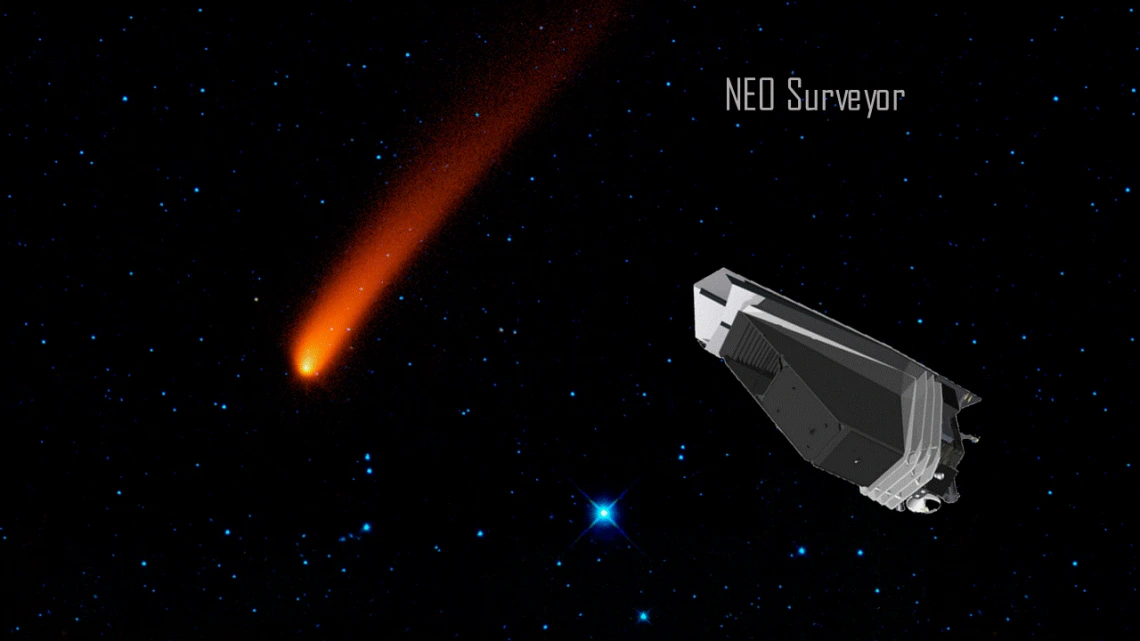UArizona Looks Toward Work on NASA’s Potential Asteroid-Hunting Space Telescope

Professor Amy Mainzer of the Lunar and Planetary Laboratory will provide technical leadership for the projected Near-Earth Object Surveillance Mission, which will include the NEO Surveyor spacecraft.
The University of Arizona is spearheading work that would begin efforts to construct a space-based infrared telescope that could provide the capabilities NASA needs to search for asteroids and comets that pose impact hazards to Earth, called near-Earth objects, or NEOs.
Professor Amy Mainzer of the Lunar and Planetary Laboratory at the University of Arizona will provide technical leadership for the projected mission, to be in partnership with the Jet Propulsion Laboratory. The Near-Earth Object Surveillance Mission, or NEOSM, consists of a spacecraft, to be called the NEO Surveyor, that would continuously collect infrared images of near-Earth space, and the investigation team which will process, analyze and archive the data from it.
The spacecraft will use highly sensitive heat-sensing cameras to detect the infrared glow from asteroids and comets that are warmed by the sun as they get close to the orbit of Earth. Searching for asteroids by sensing their heat emission allows astronomers to not only detect their position and movement in space, but also measure their sizes and identify even the darkest asteroids that may have primitive, carbon-rich surfaces.
“This mission would answer a fundamental question: Are there asteroids or comets out there that can cause harm to the Earth over the next century?” said Mainzer, who also leads NASA’s Near-Earth Object Wide-field Infrared Survey Explorer, or NEOWISE, mission that uses an older spacecraft reactivated to hunt for NEOs after it completed its original mission. The NEO Surveyor builds on the success of the NEOWISE mission, which is celebrating the 10th anniversary of its launch on December 14.
“We’ve learned a lot from NEOWISE about how many asteroids are dark versus bright, and it’s been a valuable precursor mission, but it has now operated long past its expected lifespan. With the NEO Surveyor spacecraft, we can use what we’ve learned from NEOWISE to build a more highly capable and long-lasting spacecraft that will greatly complement the existing network of ground-based telescopes searching the skies for hazardous objects.”
The NEO Surveyor infrared space telescope could be launched as soon as 2025 if work begins next year and would survey the skies for at least five years to greatly increase the catalog for more than 90% of asteroids larger than 460 feet (140 meters), as directed by the United States Congress. Its projected design is optimized for this task by carrying two 16-megapixel infrared cameras capable of searching the twilight and dawn skies, where it is much harder for Earth-based telescopes to observe. The telescope would be placed at a gravitationally stable point between Earth and the sun called the Lagrange 1, or L1 point. The L1 location helps the telescope cool to minus 390 degrees Fahrenheit (40K) without any cryogenic coolant, as it will be well away from the heat emissions from Earth.
Mainzer and her team recently met at the University of Arizona in mid-November for a kickoff team meeting to plan the next phase of the project, which will produce the documentation and reviews necessary for NASA to make the decision on whether to move into a preliminary design phase sometime next year. As the survey director, Mainzer would be responsible for all aspects of mission success, with flight project management provided by the Jet Propulsion Laboratory in Pasadena, California. The NEOSM is an element of NASA’s Planetary Defense Program managed by the Planetary Defense Coordination Office, which is tasked to detect, assess and lead efforts in response to any threat of asteroid and comet impacts.
“More than half of all known potentially hazardous asteroids were discovered by the Catalina Sky Survey and Spacewatch telescopes operated by the University of Arizona over the past two decades,” said University of Arizona President Robert C. Robbins. “We have a longstanding tradition as a pioneer in planetary defense, and we are very proud to bring this history to the next level to help protect our planet from impact hazards.”
“At the University of Arizona, we believe that university partnerships are going to be critical to successful planetary defense, and we have supported and created capabilities to do just that,” said University of Arizona Senior Vice President for Research and Innovation Elizabeth R. “Betsy” Cantwell. “Dr. Mainzer’s leadership of a core university team focused on this new mission is critical, given her leadership of the original concept. The NEO Surveyor provides a platform for Dr. Mainzer and the University of Arizona to advance the most impactful science for this mission.”
The University of Arizona would provide scientific leadership of the overall mission, build and test the flight infrared detector assemblies, monitor the observatory’s performance, manage the investigation team, and support operations after it is launched. The Jet Propulsion Laboratory will manage the flight project with guidance from the survey director. Other major partners include Ball Aerospace (Colorado); Space Dynamics Lab (Utah); Teledyne (California); L3 Harris (Massachusetts); University of Rochester (New York); IPAC (California); Planetary Science Institute (Arizona) and the University of California, Los Angeles.

